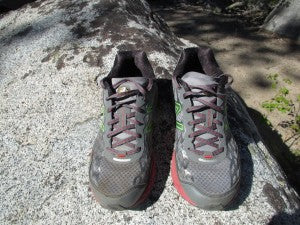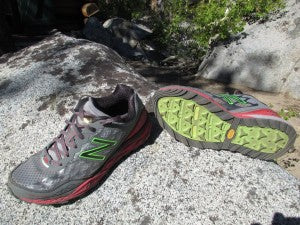The Leadville 1210 is a great addition to New Balance’s quiver of trail shoes, providing a more substantial option to the arsenal of truly minimal footwear options they have been near the forefront of for the past few years (think the Tony Krupicka-inspired 100/101 and Minimus Trail lines). It is neither a featherweight nor a heavyweight, splitting the difference at 10.3 ounces but, in my opinion, it does feel lighter on the foot than its actual weight. And, with an 8mm heel-to-toe drop it certainly blends in more with the traditional shoe crowd and its offsets of 10-14mm than it does with the pancake-flat and wafer-thin minimalists. My observation is that the 1210 feels as though it rides higher than the Brooks Cascadia, even though the Cascadia has a 10mm drop. This could be due to the supreme amount of cushioning in the heel of the 1210.

The shoe design was born out of three-dimensional measurements of ultrarunners’ feet and how they morph over the course of a hundred miles (such as the Leadville Trail 100 in Colorado the shoe is named after). Although this is a great concept for shoe design in theory, in everyday-life actuality it creates a sizing dilemma. In addition, the shoe is constructed on New Balance’s UL-1 last which has a wider heel and instep height.
The shoe is VOLUMINOUS from the heel through the forefoot and wearing my normal size I was swimming in the shoe and no amount of lacing trickery or sock-thickness adjustment seemed to adequately alleviate this. I decided to step-down ½ size and this mostly took care of the issues, although I still use the “rabbit-ears” heel-lock lacing technique and I’ve noticed that my big toes are somewhat-irritated by rubbing against the toebox where it begins to taper toward the toe bumper. This is a minor nuisance but something that would definitely become an issue on long runs or outings with long descents. So, essentially, my normal size would work for ultra-distance runs (and would make an ideal drop bag shoe for the late stages of a 100-miler) but I decided to go with the smaller size in order to put the shoe in the weekly training rotation. To the contrary of my sizing issues, a friend of mine started running in the Leadville 1210 in his normal size in April and ran the High Sierra 50 Mile with them to great satisfaction.

In spite of my difficulty dialing in my size I really enjoy running in the Leadville 1210. I recently took them for a spin on some alpine singletrack in the Eastern Sierra’s Rock Creek Canyon, just north of Sage To Summit’s home in Bishop, CA. Taking the shoe and testing its flexibility with your hands gives the impression of a fairly stiff outsole, however the shoe feels incredibly responsive when running. I’ve even pounded some pavement on mixed terrain loops and was impressed with its smooth heel/mid-foot to toe ride. It did not feel clunky on the asphalt.
The 1210s are incredibly well-cushioned (maybe overly so for technical trails) with a RevLite foam material that is 30% lighter when compared with the weight of comparably-cushioned midsoles. New Balance calls this a stability shoe but I would quibble with that label. There is a medial post of higher density compression-molded EVA in the rearfoot but it feels soft directly beneath the arch in the midfoot zone and this combined with an elevated stack height and a roomy synthetic mesh upper with only modest overlay reinforcements leads to a feeling of decreased stability on uneven surfaces and descents.
The outsole is well-lugged and constructed with durable Vibram rubber giving you confidence in traction. With a flexible rock plate and a well-cushioned midsole the protection underfoot is solid without creating a clunky, four-wheel drive “tank” feel.
Finally, the upper has been assembled with limited seam and flexible overlay construction making for a very comfortable feel. The tongue is sown to the upper all the way forward which helps to eliminate debris intrusion. There have been some complaints that the tongue is too short causing issues with laces slipping over it directly onto the foot and also that the tongue is not padded enough to soften the lace pressure. I have not experienced either of these issues.

I still need some more technical trail miles underfoot with this shoe to know for sure whether it will be a go-to mountain running shoe for longer hauls for me but, regardless of that, I am really psyched on the Leadville 1210. If you’re looking to start experimenting with dropping your heel down towards zero without initially sacrificing any cushioning or protection this shoe would be a great option. Those same features would make it a solid choice for a fastpacking trip where the extra 15-20 pounds on your back will add to the impact forces your feet are forced to absorb. And, finally, for those that rarely have more than 1 or 2 arrows in their running shoe quiver the Leadville 1210 would make a great all-around shoe, performing well on smooth dirt roads (and pavement when necessary), and rougher trails, both flat and with significant elevation change.


